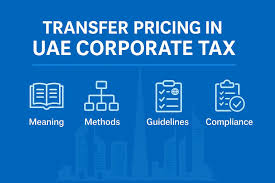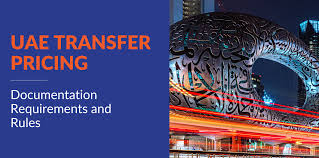Now Reading: Transfer Pricing in the UAE: New Documentation Requirements and Compliance Strategies for 2025
-
01
Transfer Pricing in the UAE: New Documentation Requirements and Compliance Strategies for 2025
Transfer Pricing in the UAE: New Documentation Requirements and Compliance Strategies for 2025

Table of Contents
The United Arab Emirates (UAE) introduced a comprehensive transfer pricing (TP) regime under Federal Decree-Law No. 47 of 2022, effective for financial years starting on or after June 1, 2023, aligning with the 9% corporate tax (CT) framework and OECD Transfer Pricing Guidelines.
In 2025, new documentation requirements, including the Transfer Pricing Disclosure Form (DF) and thresholds for Related Party Transactions (RPTs) and Connected Persons (CPs), intensify compliance demands. With the Domestic Minimum Top-up Tax (DMTT) of 15% for multinationals (MNEs with global revenues ≥ €750 million) effective January 1, 2025, and anticipated Advance Pricing Agreements (APAs) from Q4 2025, businesses face heightened scrutiny.
This guide outlines 2025 TP documentation requirements, compliance strategies, and insights from Sharjah’s free zone model to ensure adherence and optimize tax outcomes in the UAE’s evolving tax landscape.
1. Transfer Pricing Framework in the UAE (2025)
Legal Basis
- Legislation: Federal Decree-Law No. 47 of 2022 (CT Law) mandates TP compliance under Articles 34 (arm’s length principle), 35 (related parties/CPs), and 55 (documentation). Ministerial Decision No. 97 of 2023 and the FTA’s Transfer Pricing Guide (October 23, 2023) provide detailed guidance.
- Alignment: Adheres to OECD TP Guidelines, requiring transactions between related parties to reflect market (arm’s length) values, using methods like Comparable Uncontrolled Price (CUP), Resale Price, Cost Plus, Transactional Net Margin (TNMM), and Transactional Profit Split.
- Scope:
- Taxable Persons: All UAE businesses, including mainland and free zone entities, unless exempt (e.g., government entities, natural resource extraction).
- Related Parties: Entities with ≥50% common ownership/control or significant influence (e.g., parent-subsidiary, joint ventures). Government-owned entities under federal/local control are exempt from TP rules per FTA Public Clarification (July 2024).
- Connected Persons (CPs): Owners, directors, or officers with significant control, including their related parties.
- DMTT Integration: MNEs subject to 15% DMTT must align TP policies with Pillar Two rules, ensuring a minimum effective tax rate, with disclosures in FY 2025 financial statements.
Key Documentation Requirements

- Local File: Mandatory for all taxable persons with RPTs, detailing entity-specific transactions, TP methods, and benchmarking. Must be maintained contemporaneously (at transaction or tax return filing).
- Master File: Required for UAE-based groups with international operations, outlining global TP policies, business structure, and value drivers. Exempt for purely domestic groups.
- Country-by-Country Reporting (CbCR): Applies to MNEs with global turnover > AED 3.15 billion (€750 million), providing jurisdictional financial data (e.g., revenue, profits, taxes).
- TP Disclosure Form (DF): Introduced November 11, 2024, via the FTA’s Corporate Tax Guide for Tax Returns (TRG). Must disclose:
- Exemptions:
- Record-Keeping: Maintain IFRS-compliant records for 7 years, with audits mandatory for revenues > AED 50 million or Qualifying Free Zone Persons (QFZPs).
Penalties
- Non-Compliance: Fines range from AED 10,000 (late DF submission) to AED 1,000,000 (CbCR violations). General penalties align with the Tax Procedures Law of 2017.
- QFZP Risk: Failure to meet TP compliance disqualifies QFZPs from 0% CT, revoking status for the current and subsequent four years.
Comparison to Sharjah

- Sharjah’s Free Zones: Entities in Sharjah Media City or Sharjah Publishing City benefit from 0% CT as QFZPs but must comply with TP rules for RPTs, similar to Dubai’s free zones (e.g., DIFC, Jebel Ali). Sharjah’s lower setup costs (AED 5,750–11,500 vs. Dubai’s AED 10,000–20,000) ease compliance burdens.
- Advantages: Sharjah’s SME focus and streamlined licensing mirror UAE’s Small Business Relief, but Dubai’s global hub status increases TP scrutiny for MNEs.
2. New Documentation Requirements for 2025
Transfer Pricing Disclosure Form (DF)
- Thresholds:
- Self-Review Approach: Taxpayers must assess arm’s length compliance, report adjustments, and maintain supporting documentation.
- Filing: Submit with CT return (within 9 months of financial year-end, e.g., September 30, 2025, for FY December 31, 2024).
Local and Master File Updates
- Local File Content:
- Master File Content:
- Timing: Prepare contemporaneously; submit upon FTA request (typically within 30 days).
CbCR and APA Developments
- CbCR: MNEs with > AED 3.15 billion turnover must file annually, detailing jurisdictional financials. Non-compliance fines up to AED 1,000,000.
- APAs: Unilateral APAs applications open in Q4 2025; bilateral APAs to follow. Requires detailed transaction data and TP method justification. Decision No. 2 of 2025 outlines application process.
Challenges
- Complex Group Structures: UAE businesses with pre-CT intra-group transactions lack arm’s length frameworks, complicating compliance.
- Benchmarking Data: Limited Middle East comparables necessitate reverse benchmarking or reliance on Eastern European data, increasing complexity.
- Low CP Threshold: AED 500,000 CP threshold captures most businesses, requiring detailed reporting.
3. Compliance Strategies for 2025
Documentation Strategies
- Robust Documentation:
- Prepare Local File and Master File contemporaneously, using TPGenie or similar software for OECD-compliant reports.
- Conduct benchmarking with Middle East/Eastern European comparables, using databases like Bloomberg or Orbis.
- Example: A Dubai-based MNE with AED 50 million RPTs should maintain a Local File with CUP method analysis, supported by regional comparables.
- TP Disclosure Form:
- Audit Readiness:
Operational Strategies

- Policy Review and Restructuring:
- PropTech Integration:
- APA Applications:
Risk Mitigation
- Engage Experts:
- Monitor FTA Updates:
- Sharjah’s Model:
- DMTT Alignment:
Taxation Context
- CT Interaction: TP adjustments impact taxable income (9% CT above AED 375,000). Non-arm’s length transactions increase CT liability.
- VAT (5%): Applies to commercial RPTs; ensure TP documentation supports VAT compliance.
- Free Zone Benefits: QFZPs maintain 0% CT on qualifying income but require TP compliance for RPTs to avoid status loss.
4. Recommendations for 2025
- Immediate Actions (Q1–Q2 2025):
- Action: Register with EmaraTax by March 31, 2025, for natural persons or non-licensed entities. Prepare Local File and DF for RPTs > AED 40 million and CP payments > AED 500,000.
- Example: A Dubai MNE with AED 60 million RPTs should file DF by September 30, 2025, for FY 2024, using TNMM with regional benchmarks.
- Rationale: Ensures compliance and avoids AED 10,000–1,000,000 penalties.
- Strategic Compliance (2025):
- Action: Review TP policies with KPMG or Deloitte, aligning intercompany agreements with arm’s length terms. Apply for unilateral APAs in Q4 2025 for high-value RPTs.
- Example: A Sharjah free zone firm with AED 20 million RPTs can secure an APA for intra-group loans, ensuring QFZP status.
- Rationale: Minimizes audit risks and secures tax certainty.
- Sharjah as a Hedge:
- Action: Allocate 20–30% of operations to Sharjah’s free zones (e.g., Sharjah Media City) for 0% CT and lower compliance costs, maintaining Local File for RPTs.
- Example: A Sharjah SME with AED 5 million RPTs can use TPGenie for Local File, leveraging Small Business Relief.
- Rationale: Balances Dubai’s scrutiny with Sharjah’s affordability.
- Long-Term Planning (2026–2030):
- Action: Integrate TP with DMTT compliance, using PropTech for automated documentation. Invest in sustainable operations (e.g., The Sustainable City) to align with Net-Zero 2050, reducing costs.
- Example: An MNE with AED 4 billion turnover can file CbCR and DMTT returns, supported by OECD-compliant TP policies.
- Rationale: Ensures global alignment and long-term tax efficiency.
- Operational Excellence:
- Use TPGenie or QuickBooks for documentation, engage BMS Auditing for compliance, and monitor DLD/FTA data for market trends.
- Example: A Dubai retailer can automate DF preparation, saving AED 50,000 in compliance costs annually.
Conclusion
The UAE’s 2025 TP regime, under Federal Decree-Law No. 47 of 2022, imposes stringent documentation requirements, including the TP Disclosure Form (RPTs > AED 40 million, CPs > AED 500,000), Local/Master Files, and CbCR for MNEs (> AED 3.15 billion turnover). With unilateral APAs launching in Q4 2025 and 15% DMTT for MNEs, businesses face increased compliance demands. Strategies like robust documentation, PropTech adoption, and APA applications, inspired by Sharjah’s cost-efficient free zone model, ensure arm’s length compliance and tax optimization. By leveraging experts, monitoring FTA updates, and aligning with OECD standards, businesses can navigate TP challenges, avoid penalties (AED 10,000–1,000,000), and thrive in the UAE’s dynamic tax landscape.
READ MORE: High-Value Employment Tax Credits: Attracting Top Talent to the UAE in 2025
WATCH MORE: https://www.youtube.com/watch?v=MksI-36Rw8I






















